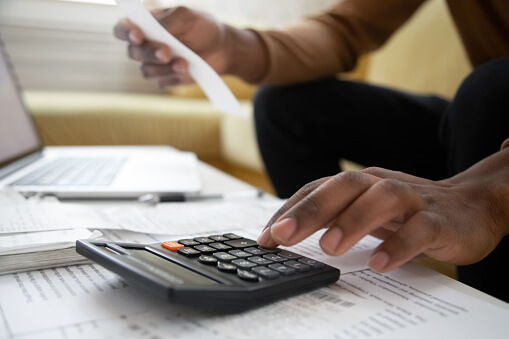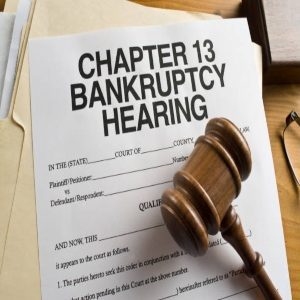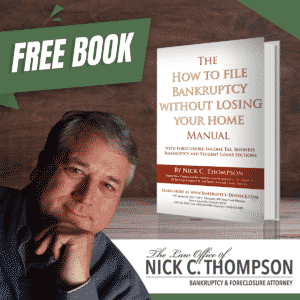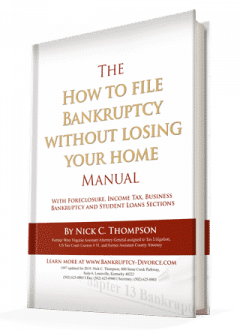Interestingly, Chapter 13 is sometimes less expensive than Chapter 7. For instance, Chapter 7 does not have to repay the priority and secured creditors. But, every Chapter 13 bankruptcy plan must repay the priority claims and secured arrearages. Since the interest and penalties are repaid partly for these unsecured debts, Chapter 13 might be less expensive. So, continue reading to learn how to calculate your Chapter 13 bankruptcy mortgage payment plan.
How to Calculate Your Chapter 13 Payment Plan
First, unsecured claims can be discharged and eliminated in 100%, 70%, 50%, or even 1%–0% plans. But, bankruptcy law requires you to repay your disposable income into the Chapter 13 plan. Therefore, the percentage can increase for the 3–5 years for which you have to be in a plan.
Please note that if you make over the average income for your size family, you must file a 5-year plan. People who make less than the average disposable income can file for a 3-year plan.
Filing at 100%
At 100%, you do not need to file an annual budget in the Western District for the State of Kentucky or turn over your tax refund. However, many states require debtors to turn over their tax refunds. This is because it is income over and above your monthly budget.
If you are repaying in full, there is no need to file the annual budget or to turn over the tax refund. Inheritances and personal injury settlements above the exemptions are used as an asset to repay debts during the case.
Filing at 70%
At 70%, almost all the judges assume the plan is present in good faith. If the plan is in good faith, the judge will not review the plan unless a creditor objects. Judges Stout and Fulton assume the plan is proposed in good faith at 50% in the Western District of Kentucky. Judge Lloyd will require 70%.
Filing at 50%
Below 50% of all our Western Kentucky Judges will review the case. The judge will increase the plan payments if a debtor has luxury items, inflated or actual expenses, or underestimated monthly income. A debtor may have a home mortgage or reasonable car expense that is allowable. But, a boat, motorcycle, or expensive sports car may not be allowed in a 10% plan.
Feasibility, a Sample Problem for a Chapter 13 Bankruptcy Monthly Payment Plan
One of the significant calculations you must do in Chapter 13 bankruptcy is that it must be feasible. That means it has to repay as much as Chapter 7 would have. Feasibility also means that secured debts for items you keep and priority debts are paid in full.
One of the common reasons for filing a Chapter 13 bankruptcy is when if a Chapter 7 were filed, property would have to be sold. You can keep $28,900 in equity for every person on the deed to the home in 2022.
But if a husband and wife are on the deed, they can have $57,800 in equity, both of them are allowed 28,900. But they can’t keep $125,000 in a Chapter 7 case and expect the trustee not to sell the home.
As a result, if a couple does have 125,000 in equity they would be allowed to deduct their 57,800. Only 125,000 – 57,800 or 67200 has to be repaid in Chapter 13 bankruptcy if they have 125,000 in equity. This would allow the debtor to keep the house by repaying 67,200.
However the debtor can also deduct the cost of the sale (about $12,000) and the fees the trustee would charge (about $10,000), but the Chapter 13 bankruptcy plan still must repay about 45,200 dollars. This may still be a bargain if you discharge a million in secured debt for $45,200.
How does a Chapter 13 Bankruptcy Plan Pay Fees to the trustee?
Every Chapter 13 plan pays a fee to the trustee. This trustee is typically as much as 10%, but in the Western District of Kentucky, it is only 4.5%. In many jurisdictions like Indiana, the trustee may require you to pay the home mortgage monthly payments through the trustee. This is called a conduit plan. It makes a Chapter 13 Trustee’s bankruptcy practice much more profitable and punishes mortgage creditors.
The justification for a conduit Chapter 13 plan is it allows the Trustee to supervise the mortgage company more and prevent abusive fee-charging by the mortgage company. The mortgage creditors receive about 95% of their charges if the trustee is in a conduit state.
Kentucky is not a conduit state, and your normal monthly mortgage repayment is paid directly to the mortgage company. Your mortgage payments restarts the month you file a Chapter 13 in Kentucky. The Chapter 13 plan payments also begin the month you file, not when your hearing begins.
To calculate your plan payment, you must essentially look at your budget. Your plan payment is what you have left after deducting your reasonable and necessary expenses from your income. We call this your disposable income. There must be enough left to fund the plan and repay the secured arrearages and priority secured debts.
Common Chapter 13 Bankruptcy Plan Payment Calculation Problems
There is a floor in calculating a Chapter 13 bankruptcy plan payment. Every plan must meet the following criteria:
- Cover what has to be repaid due to feasibility, even if there is an early discharge.
- Cover the administrative, secured, and priority expenses. Attorney fees are an administrative expense, just like trustee fees. In 2018 in Kentucky, the attorney fees are $4,100 for an uncontested Chapter 13. In Indiana, it is $4,000, and the fees are higher in much of the country.
The amount available to the unsecured creditors is what remains after the administrative, secured, and priority expenses are paid. You get the plan percentage if you divide what is available to pay the unsecured creditors by the amount of the unsecured claims. Plan percentage = ((amount to be repaid to the unsecured)/(amount of the claims)).
Counsel for the debtor always wants this to be as close to zero as possible if he believes he can get a low plan percentage approved. If the payment is too high, the client can’t afford it, which is another feasibility problem. But, if the payment is too low, it doesn’t cover enough of the necessary expenses of the plan.
The client typically wants a discharge at the end of the plan. Any unsecured and secured debts which are cosigned may also need to be paid in full to protect the cosigner. Only unsecured debts paid in full protect the cosigner.
There Are Different Methods For Calculating Bankruptcy Chapter 13 Payments
When a Chapter 7 is done, you are often left in debt for income taxes which were less than 3 years old, and car and mortgage defaults. Normally these debts are not caught up during the Chapter 13. These problems remain.
Chapter 13 plans must pay or cure secured and priority expenses or defaults. The monthly payment must be calculated to use your best efforts to repay. And this debt relief option must repay over time as much as Chapter 7 would have.
The Expenses Factor
Every Chapter 13 plan must repay the priority claims (taxes) and secured arrearages for the property you keep in full. But second mortgages can be stripped if they have no equity, and private student loans can become so challenging to collect in our district that they become essentially uncollectible.
Interest and penalties can be partially reduced and repaid for some secured and priority debts in Chapter 13 bankruptcy. Unsecured debts get zero interest in a Chapter 13 bankruptcy and are often repaid at less than 10%. There are even 0% plans.
The Disposable Income Factor
Bankruptcy law requires you to repay all of your disposable income into the plan. Judges often refer to this as an income driven plan. There are also asset driven plans when the assets are so high that plans are driven by the amount of assets. Finally there are debt driven plans where the amount to be repaid depends on how much debt has to be repaid.
The Non-Exempt Assets Factor
Every Chapter 13 has to repay as much as Chapter 7 would have paid to be feasible. One of the common reasons for filing a Chapter 13 bankruptcy is that if it were filed as a Chapter 7, the property would have to be sold. You can keep close to $29,000 in equity for every person on the deed to the home in 2022. Bankruptcy expects you to keep enough property to obtain a fresh start but not so much that creditors bleed.
Funds from personal injury cases and inheritances are often used to repay debts. You are allowed a small exemption to keep a reasonable amount of property and this can include the exemption for personal injury cases.
Belt tightening and plan percentage increases.
You are required to use your best efforts to repay. They often use the term that both creditors, and debtors have to tighten their belts in their financial affairs, expenses, and payroll deductions. They expect debtors’ monthly expenses to be reasonable and not extravagant. Therefore, the percentage or monthly payment can increase or decrease for the 3–5 years you are in a plan.
Not all creditors file claims, and what you thought was a 10% plan may become a 50% one because claims were not filed. An increase in the plan percentage by our trustee does not mean you pay more. Instead it means the creditors who have filed claims are rewarded by obtaining larger percentages. The deadline to file claims is about three months after filing the case. You should always review your claims.
How Many Months Is A Chapter 13 Repayment Plan?
For above-average income debtors, plans must be 60 months. For below-average income debtors, the plans can be 36 months. If you are paying back 100%, the plan can be shortened, but generally, you cannot otherwise pay it off early without making it into a 100% plan. They use your monthly income for the prior six months to calculate your annual income and payment.
How to Calculate Your Chapter 13 Payment Plan?
First, unsecured debt can be repaid in 100%, 70%, 50%, or even 1%–0% plans. Your disposable income, type of debt, and the amount of equity you have will increase or decrease your payment. Everyone wants the minimum plan payment.
But calculating your minimum plan payment requires planning. Planning may allow you to keep or purchase a car for 600 a month and have a 400 per month plan payment instead of having 1000 per month going to your plan payment.
. Please note that if you make over the average monthly income for your size family, you must file a 5-year plan. People who make less than the average monthly income can file for a 3-year program.
Chapter 13 Bankruptcy Payment Calculator
This is a simple Chapter 13 Bankruptcy plan payment calculator.
| Chapter 13 Bankruptcy | |
| Disposable income over 60 months Example 1000×60 | $ 60,000.00 |
| Excess Equity above exemptions Example 30,000 over home exemption | $ 30,000.00 |
| Required Secured & Priority payments, Example Mortgage arrearage | $ 20,000.00 |
| Greater of the above three amounts | $ 60,000.00 |
| No look attorney fees | $ 4,000.00 |
| Trustee fees .045% | $ 2,700.00 |
| Total required for payback | $ 60000.00 |
| Divided by the Number of months of the plan, usually 60
Below average income can have a 36-month commitment period, but monthly payments and attorney fees decrease slightly for 36-month projects. |
60 |
| Required Plan Payment | 1000 |
| Remember Chapter 13 monthly payments can start lower in step plans. | |
| Step plans increase or decrease if you know income will change. | |
You Don’t Have to Pay the Full Amount in Chapter 13
100%, 70%, and 50% repayment plans have different benefits, plus you can also later modify a plan or obtain an early discharge if it becomes difficult. People can become disabled and may be unable to finish a plan so early discharges are available when completing a plan becomes impossible due to no fault of your own.
How To Calculate Interest On Bankruptcy Claims?
Unsecured creditors. Unsecured debts are typically repaid with 0% interest and fees on their claims. In Kentucky, our state courts allow a 6% interest on judgments by statute, but in Bankruptcy court, even judgments on unsecured claims are paid 0%.
This is a substantial saving. If you had to repay a judgment through a garnishment in state court, the debt could double every five years. But in bankruptcy court, you only refund the principal amount of the debt.
Secured creditors usually are only repaid 1 or 2% above the prime interest rate. If they only have a lien on personal property, I have often negotiated liens at 0%. Residential first mortgages, however, get their stated interest rate at whatever is in the contract. A Chapter 13 bankruptcy cannot modify mortgage payments.
Other secured debt can often be modified or stripped based on the security and timing. If you have a $1500 5 % monthly payment, it continues to be a 5% mortgage while it is in bankruptcy. The default or arrearage must be repaid plus any attorney fees and court costs that accrued before filing your bankruptcy.
Priority creditors get the interest they are allowed in their statutes. Priority debts include income taxes less than three years old and State property taxes. The IRS statute gives a 12% interest rate, while Kentucky gives a 12% rate to property taxes. Kentucky statutes allow a 12% rate for property taxes. Then, federal and state taxes are given the same consideration in repayment.
Chapter 13 Bankruptcy Monthly Payments Take Your Disposable Income
One of the significant calculations you have to do in Chapter 13 is that it must repay your best efforts. You can deduct secured debt, including car and personal loans, and necessary expenses from your net income to arrive at your monthly payment.
The bankruptcy attorney-client relationship does not allow the lawyer to tell the client they must go out and get a car loan before filing and then include it in the monthly expenses.
The plan may not be feasible if you don’t include deductions for a car to get to work or for paying taxes. A plan that does not allow you to pay for medical expenses or home repairs won’t work. It won’t be feasible.
The client may need an auto to get to work. Instead of having a 1000 dollar-a-month Chapter 13 plan payment to creditors, the client could have a 600-per-month car payment and a 400-per-month Chapter 13 monthly payment. But it would violate the bankruptcy code to tell the client to load up with debt before filing. However, a car payment is a reasonable and necessary expense that should be allowed. A Ford is a reasonable expense as long as it is not a Mustang Super Snake. A Ferrari is not a reasonable expense.
Approach Us To Calculate A Great Chapter 13 Plan Monthly Payment
If you are considering bankruptcy, don’t delay because timing is crucial. I am here to help you. So, contact my office immediately to start the conversation—Nick C. Thompson, Bankruptcy Lawyer: 502-625-0905.
 Resources for Bankruptcy
Resources for Bankruptcy
Louisville, Kentucky Bankruptcy Forms
How to Calculate Chapter 13 Plan Payments • Video
How to Win Great Chapter 13 Plan Payments • Video
Why Review a Chapter 13 Schedule of Allowed Claims?
If you are considering bankruptcy, don’t delay because timing is crucial. I am here to help you. So, contact my office immediately to start the conversation—Nick C. Thompson, Bankruptcy Lawyer: 502-625-0905.







